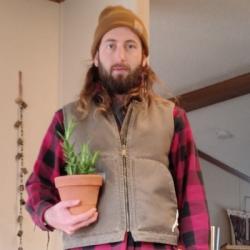
Actors in the Emerging Theatre Artist Residency rehearse a play at Krista Detor and Dave Weber’s artist retreat, The Hundredth Hill, in northern Monroe County. Since moving to the retreat in August, these recent graduates from NYU’s Tisch School of the Arts have been working on two productions that they will perform for live audiences on a custom-built, outdoor stage on the property. | Limestone Post
“The whole world’s changing,” says Krista Detor, world-renowned musical artist and longtime Bloomington resident. And one of the answers for her is, and always has been, art. Detor, inspired by her own experiences with artist residencies, is creating a space for other artists on her and her husband Dave Weber’s property, The Hundredth Hill, secluded in the forest halfway between Dolan and Hindustan. “One day I looked up and that was a garden shed, and I said, ‘Dave, I think we should build a guest house,’” Detor says as we chat at one of the many sit-and-gather spots sprinkled about the property. It was an “if you build it they will come” feeling she says.
Detor wasn’t wrong. The Hundredth Hill is presenting back-to-back weekends in October of live stage performance as the finale to a two-and-half-month-long theater residency hosted on the property. Through a connection to a friend in New York, Detor helped formulate the plans for a living art project that defies convention and sets the bar for how to responsibly create and present theater, despite an ongoing global pandemic. But even before the catalyst of COVID-19, the seed of The Hundredth Hill’s Artist Residency had already been planted deep, and it was Detor’s dream to see it grow.
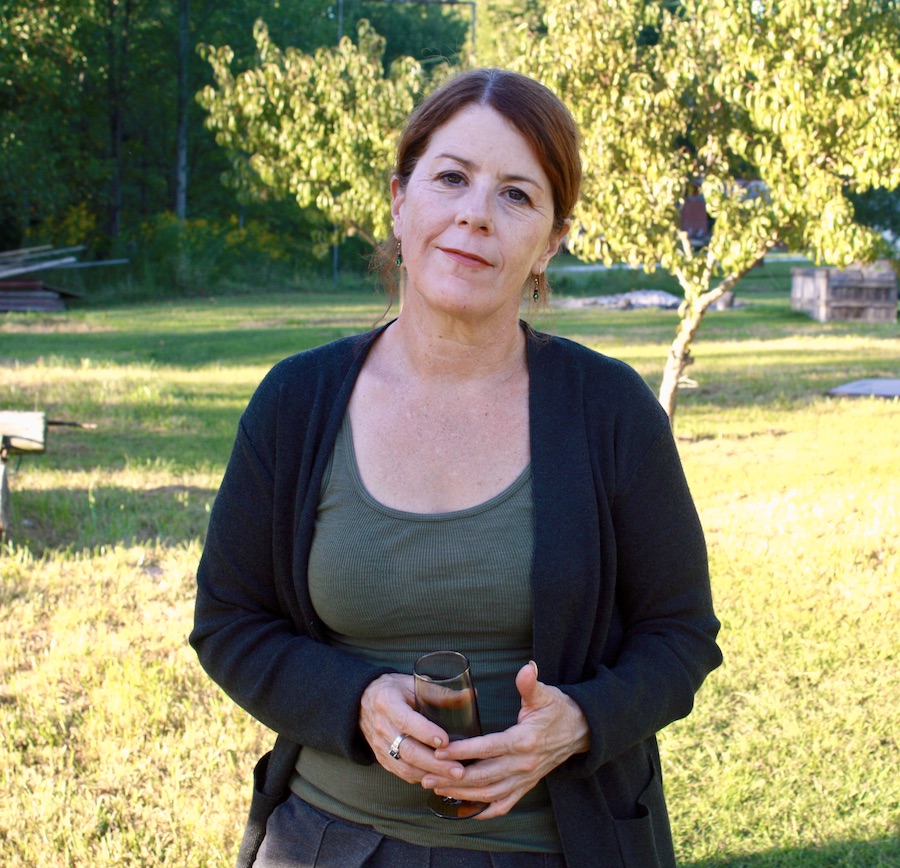
Krista Detor (above) and her husband, Dave Weber, run The Hundredth Hill, a private, nonprofit artist retreat on their property just north of Bloomington. | Photo by Grayson Pitts
Detor met Weber at Airtime Studios, a full-service recording facility, and they were married on the property in 1999. “Bloomington’s my mother’s hometown,” she says. “I spent every other summer here [in Bloomington] as a child.” Her grandfather is Earl Young, “As in Earl Young Road,” she says with pleasure. Detor’s gaze turns to the rolling green swath of meadow between forested hills. “It looks like it could go on forever,” she says. “I sit here and that is west and that direction is the Pacific Northwest — areas that I loved so much that I thought that’s where I would land, then I landed here.” And here is The Hundredth Hill. “Well, because look at that view.”
Weber and Detor have hosted musical artists on their property before, and Airtime Studios has an impressive list of talent to its name, but with universal pocket-sized technology and at-home-on-your-laptop studios, it becomes more difficult for a recording studio to attract attention — especially during the COVID crisis. “You have a recording studio, you have a recording studio, everyone’s got one in their basement,” says Detor. “Where are we in that?” Her solution? “Let’s create a destination for people who are recording. Make it an experience. You get writers block or you can’t figure out a riff? Walk out into the woods, sit on a log, dance in the meadow.”
“I would like it to be basically art’s space,” Detor says. “Workshops, residencies, other people to walk in, and say, ‘Hey, I want to host a residency. What does that look like?’” One of the ambitions of The Hundredth Hill residency project is to help other people design their own residencies. “I’d like to be able to bring in other people from the community to kind of punctuate and embellish those things,” says Detor. “I like to create experience and I like to be involved in that and I’d also just like it to be a resource for nonprofits to be able to do in-service stuff. I’d like it to be something that the community does know about and is part of. That’s my primary agenda.”
On August 1, nine New York City theater practitioners, all hailing from the New York University Tisch School of the Arts, converged on The Hundredth Hill for the Emerging Theatre Artist Residency, Detor’s first major residency on the property, which she’s hosting in association with the Arts Alliance of Greater Bloomington. “This kind of thing, absolutely the first time,” Detor says. “Having this number of people that are spread out all over, into the recording studio. They’ve taken over the entire space for two months and it’s a singular occurrence.” She recognizes how this residency is shaping the future of theater by shifting ideas of how, and where, theater is performed. “New York wouldn’t be here. NYU wouldn’t have been like, ‘Hey, let’s go into rural America,’” she says. But after the success of the 2020 Emerging Theatre Artist Residency? “They will now.”

Detor says the residency is shaping the future of theater by shifting ideas of how, and where, theater is performed. | Limestone Post
The residency is an opportunity for these young artists not only to practice their craft in an environment entirely unique from New York City but also to expand the possibilities of what performance art can be during a global pandemic. “The point is making the art,” Detor says. “The point is, you’re here and you are doing theater and no one you know — no one anybody knows anywhere in the country — is doing it. But you’re doing it.” The goal is to keep the artists and their audience safe while still being able to experience theater as it’s meant to be. “Theater doesn’t exist without the audience,” says Detor. “No performance does.”
The Emerging Theatre Artist Residency
An artist residency on The Hundredth Hill’s scenic 40 acres is totally immersive. “I’m here, I’m working, we have rehearsal, that’s what it is,” says Kyndall Sillanpaa, co-founder and artistic director of the residency. At Hundredth Hill, Sillanpaa and the other residents are unbridled in their creativity. “It’s been so interesting,” she says, “because we’re so used to the rat race of New York City in the most and least cliché ways possible that it’s been so different to be able to work and only work on just this big project and not a million different things that you’re doing, but to be able to work in isolation with an isolated group of people, where the Wi-Fi is bad and it’s just you and these other people.”
These nine young artists seem to be working hard and savoring every drop of inspiration The Hundredth Hill has to offer. “They’re actors and directors. They’re in it,” Detor says. “They’re all in it hard.” Detor says she feels inspired by the effort of the young residents, seeing a hopeful future reflected in their passionate commitment to their craft. “I don’t know if it’s distance from my 22-year-old self, but they have a level of intense focus and intense commitment to the artistic processes of what they’re trying to do that I don’t recall having at that point,” she says.
To Sillanpaa, it’s a blinders-on sort of work process. “We have rehearsals all day long, and then I will drink a giant thing of coffee at nine o’clock at night and then stay up until three a.m. writing and then wake up for rehearsal at nine,” she says. “It’s far more business oriented than I thought it was going to be.” And though Sillanpaa’s work ethic is strong, it’s the collaborative effort of all nine residents, plus Detor and Weber’s hands-on involvement in the residency, that make this effort likely to succeed.
Sam McHale is co-founder and company manager for the residency. “Sam as the company manager is really our point person for things with Krista and Dave,” Sillanpaa says. McHale explains what it means to be the producer for an artist residency such as this. It’s his goal to provide the artists with as much freedom as possible to do what they came here to do. “Making sure that everything is aligned, that schedules are working out, budgets are working out, everything is happening in the right way so that the artist can just focus as much as possible on the work they are creating …” — it’s all in a day’s work, he says.
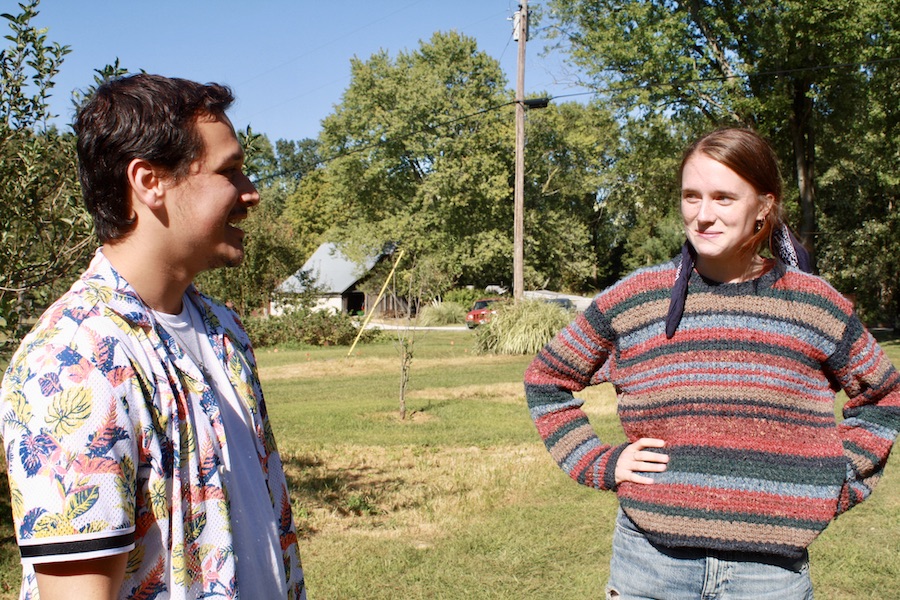
César Pinzón (left) and Nancy Kimball are glad for the opportunity to be creating art with others in-person. | Photo by Grayson Pitts
The residents paid for their own travel to the residency, but a month of serious fundraising made sure all other expenses were covered. Four-hour-long Zoom calls broke the lonely patterns of quarantine as McHale and Sillanpaa laid the foundation for the residency. Within a week they’d established a timeline, a budget, a donor venture plan. And the work continues as the residency goes on. “Sam keeps it going on the day-to-day,” Sillanpaa says. He’s their financial manager and community go-between, busy with scheduling, community outreach, grocery shopping, and stage building, all while being an actor-in-residence. At the outset of this venture, when the world was still in the initial grips of the COVID-19 pandemic, there was fear and doubt about what would happen next. But the intrepid organizers stayed vigilant. There was this idea, Sillanpaa says, of “‘You must just stay in your house and it’s the only thing you can do and you just have to hurry up and wait for it to be over,’ as opposed to figuring out how to do things in a safe way and working smarter and knowing that there are new ways to be doing things.”
Performance art during a pandemic
The Emerging Theatre Artist Residency is giving these young artists the opportunity to rise above the generational stigma they’d otherwise face in a pre-COVID theater world. “It’s like there’s this need to pay your dues,” Sillanpaa says. “Like young people can’t be in a position of power or young people can’t effectively create things independently. This idea that you must be someone’s assistant for a long time before anyone will ever trust you to do anything by yourself.” What, then, is a four-year degree at a major institution worth if no one in your chosen field will actually trust in you to succeed? It was a disheartening thought for these graduating theater students, but fate would have it another way. “And then this pandemic happens and the giant machine that is this industry can’t do anything,” Sillanpaa says. “We’re smart and capable, and yeah, there are going to be growing pains along the way, but we’re capable of figuring it out.”
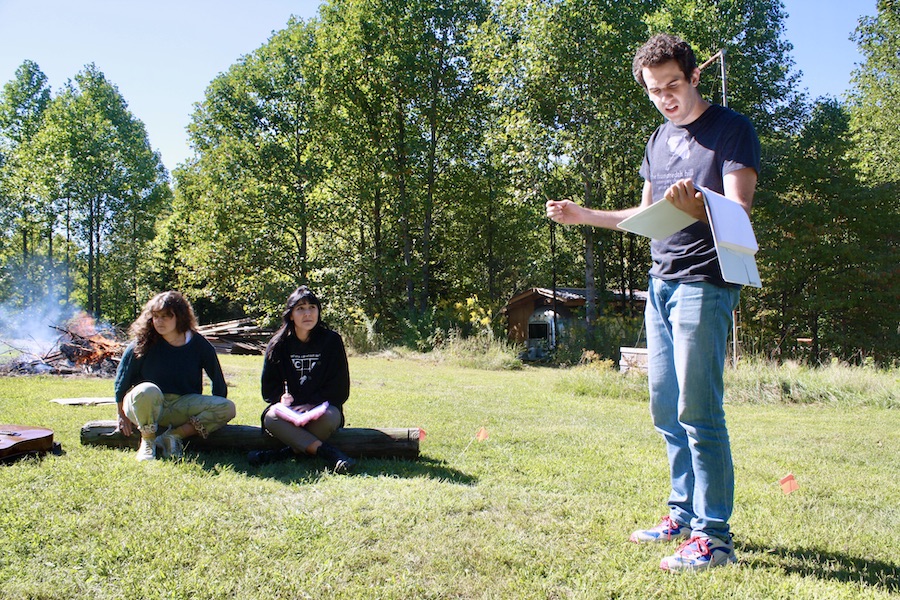
(l-r) Jess Kantorowitz, Char Nakashima-Conway, and Lorenzo Rosado rehearse at one of the many spaces available at the Hundredth Hill artist retreat. | Photo by Grayson Pitts
But it’s not all nose-to-the-grindstone work at The Hundredth Hill. It is an artist residency after all, and everyone involved speaks only positively about their experience. Says resident César Pinzón: “There were a couple of days, especially the first couple of weeks, that I’d wake up and I’d be like, ‘We’re in Indiana, on a farm with other people making art. What?’” For Pinzón, a dancer above all else, it’s the freedom to move around and to act with other people that is most important. “I’m here, and I’m getting to make art,” he says. And, at least for 2020 so far, that is a rare opportunity. The residents are grateful. “I feel very lucky to be isolated with other people in general,” says resident Brendan Schwartz. “It’s a lot more refreshing and interesting than quarantining at home. It’s also just very nice being in a space where I feel like I’m not creating art into a void.”
Living as a creative collective in an isolated refuge in the southern Indiana hills is a welcome alternative to the other modes of performance art the residents attempted before they came here. Finishing their senior year of university as a global pandemic shut down schools and all public life was a struggle they all had to face. “Last semester was all online,” says resident Nancy Kimball, whose Stella Adler Studio of Acting capstone project was conducted over Zoom, a method people in the industry are calling “Zacting.” But there’s simply something lost in trying to convert an East Village apartment into a sad kitchen in Yorkshire for a Brontë period piece performed over video chat. But Zacting is the reality of performance art during COVID. “I can’t imagine people still doing theater right now,” Kimball says. For many, the magic is lost without the presence of directors and actors, students and teachers, working in concert. “Theater’s not the same when you’re not in the same room,” Kimball says. “We’re lucky to have graduated.” Pinzón agrees: “Zacting’s hard.”

Krista Detor wanted to create “a destination” for artists. “Make it an experience,” she says. “You get writers block or you can’t figure out a riff? Walk out into the woods, sit on a log, dance in the meadow.” Here, theater resident César Pinzón does just that at The Hundredth Hill. | Photo by Grayson Pitts
Resident Jess Kantorowitz shares their sentiment. “Once people aren’t able to gather and engage with each other in an in-person way, you realize just how necessary human-to-human contact is,” she says. “Theater provides a space for a community to come together and be with one another.” A 1972 Airstream trailer, cottages constructed of repurposed and recycled materials, a large converted barn, and ample space outdoors make The Hundredth Hill Artist Residence and Retreat the ideal place for a group of ambitious minds to isolate together and dig into the rich soil of their creative spirits.
“There’s this big history of groups of theater people coming together in isolation to create things,” Sillanpaa says. “The Group Theatre worked that way. The Atlantic Theater Company was started by a group of people going to rural Vermont and creating this new wave of acting and performance.” Sillanpaa sees their troupe of nine as following in the footsteps of those who came before and finding success in their intensive retreat. “It was something I knew as a true history of the development of the pedagogies of acting — this idea of working in isolation, working somewhere that is rural, somewhere where it’s just you and a bunch of creatives trying to make something.”
‘Children’s Crusade’ and ‘Ghost Tape Number Ten’
Each of the two productions developed during the residency reflect, naturally, the experience of the artists who helped create them. Scott Huffman’s play, Children’s Crusade, follows a ragtag bunch of kids on their way to the Holy Land. “The fact that they get to play children” is an exciting idea for Huffman, he says. “I think a lot of times when you’re acting, you’re playing things that you don’t have a lot of experience with. But it’s nice to drop back into something that I think everyone has some sort of connection to. I think, because it’s like going back and looking at your youth, a lot of people can appreciate that and connect with it.”
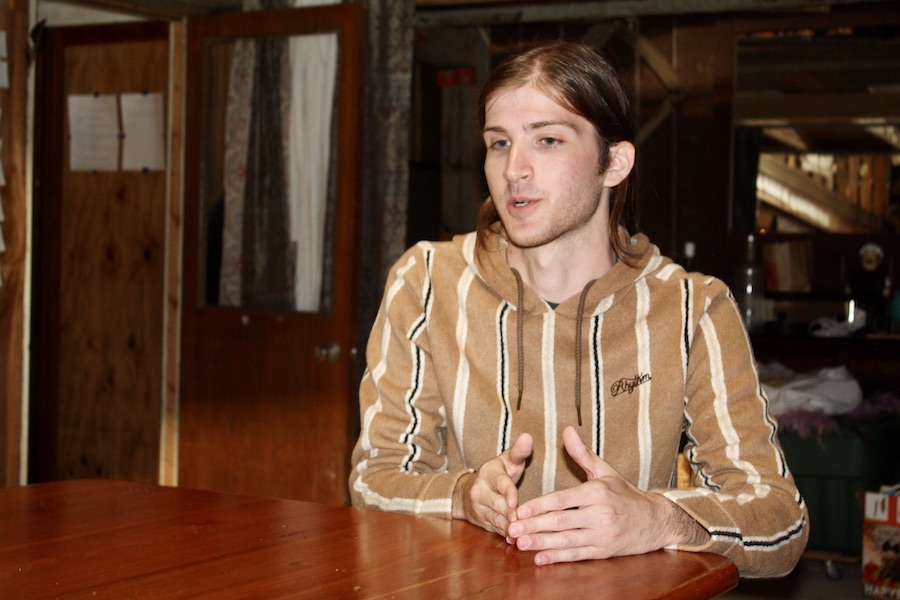
During his residency, Scott Huffman wrote the play ‘Children’s Crusade,’ which follows a group of children on their way to the Holy Land. He says the characters reflect, in a way, the experience of the artists who helped create them. | Photo by Grayson Pitts
Huffman wrote curiosity, naivety, and discovery into his play. “I’m very aware of adults playing children,” he says. Children’s Crusade looks at the child’s developing mind and personality. “I took it as the first step in your life when you can decide for yourself who you want to be and giving yourself the chance for the first time to choose the person you could become,” Huffman says. He is interested in the people who, at a young age, took it upon themselves to look for change, to look toward something that they weren’t being given and trying to find it themselves. And looking at these nine young residents at The Hundredth Hill, that is exactly what you’ll see.
The second production, Kyndall Sillanpaa’s Ghost Tape Number Ten, is decidedly not for children. The play pries apart American history, investigating the psychological game of televised terror started during the Vietnam War, when the nightly news depicted overseas death and carnage, to today’s 24-hour news feed of a nation in unrest. And though the residents are as far from war as Indiana is from Vietnam, their intensive rehearsal methods require cohesion as a unit, trust in each other, and a constant willingness to stare discomfort in the eyes, dig deep into the proverbial dirt, and make art happen.
The actual creation of the play was largely collaborative. Sillanpaa directed the actors but allowed them to breathe their own life into the creative process. “Here are your characters,” she told the actors. “Figure out who you are. You two get together and write a scene.” And as the material developed, Sillanpaa would add her own edits or written script until, eventually, there was a play. “Kyndall led us in research and discussions and individual writing partnerships that we all combined into one thing that she’s streamlining and editing,” says resident Char Nakashima-Conway. “So all of our writing is partially in there with Kyndall’s supervision and her voice editing it.” It’s this unique experience of being alone together every day for two and a half months, this grueling yet invigorating challenge of making art no matter what, that is so affirming for many of the residents involved. “We have directors, writers, actors, people who design,” Sillanpaa says. “I would like to believe that if you can figure out how to do it and you decide you want to and you want to do it well, you can make it happen if you really try.”
And it is Detor’s philosophy behind the residency that gives the artists this confidence and freedom. Detor practices “radical hospitality,” an idea that stems from her own experience at Hedgebrook, a Whidbey Island retreat that awards residencies to women artists. Detor was one of six songwriters awarded a residence in 2018. “Everything you need is available,” she says. She operates on the idea of “giving artists the real space that they need to create,” allowing them to avoid the mire of paying rent or running errands or cooking meals. “You’ve got to have an escape,” she says.
Local support
A residency such as this at The Hundredth Hill doesn’t happen without a strong backbone of sponsors and donors. Luckily for Detor and the nine young adults living on her farm for two months, Bloomington and its people are forever patrons of the arts. “We have so much local support,” says Detor. “Oliver Winery donated a bunch of wine. The Stone Age Institute, Pegasus Films, Bloomington Academy of Film and Television, Cardinal Stage, the Bloomington Playwrights Project, the Arts Alliance. Everybody got on board and has been extremely generous.” And the residents are returning the favor. They are engaged in a Zoom interaction with an arts management class at Indiana University, a radio theater class with Harmony School, and a “brain breaks” stuntology exercise with Cardinal Stage and Monroe County Community School Corporation. In the weeks leading up to the main performances, one solo artist, Lorenzo “Lolo” Rosado, has been staging one-man pop-up shows in neighborhoods around town, often with a local act opening with music before the show. Even the backdrop for the show was made by local painter Kurt Larson. “We’re utilizing every possible community resource,” Detor says.
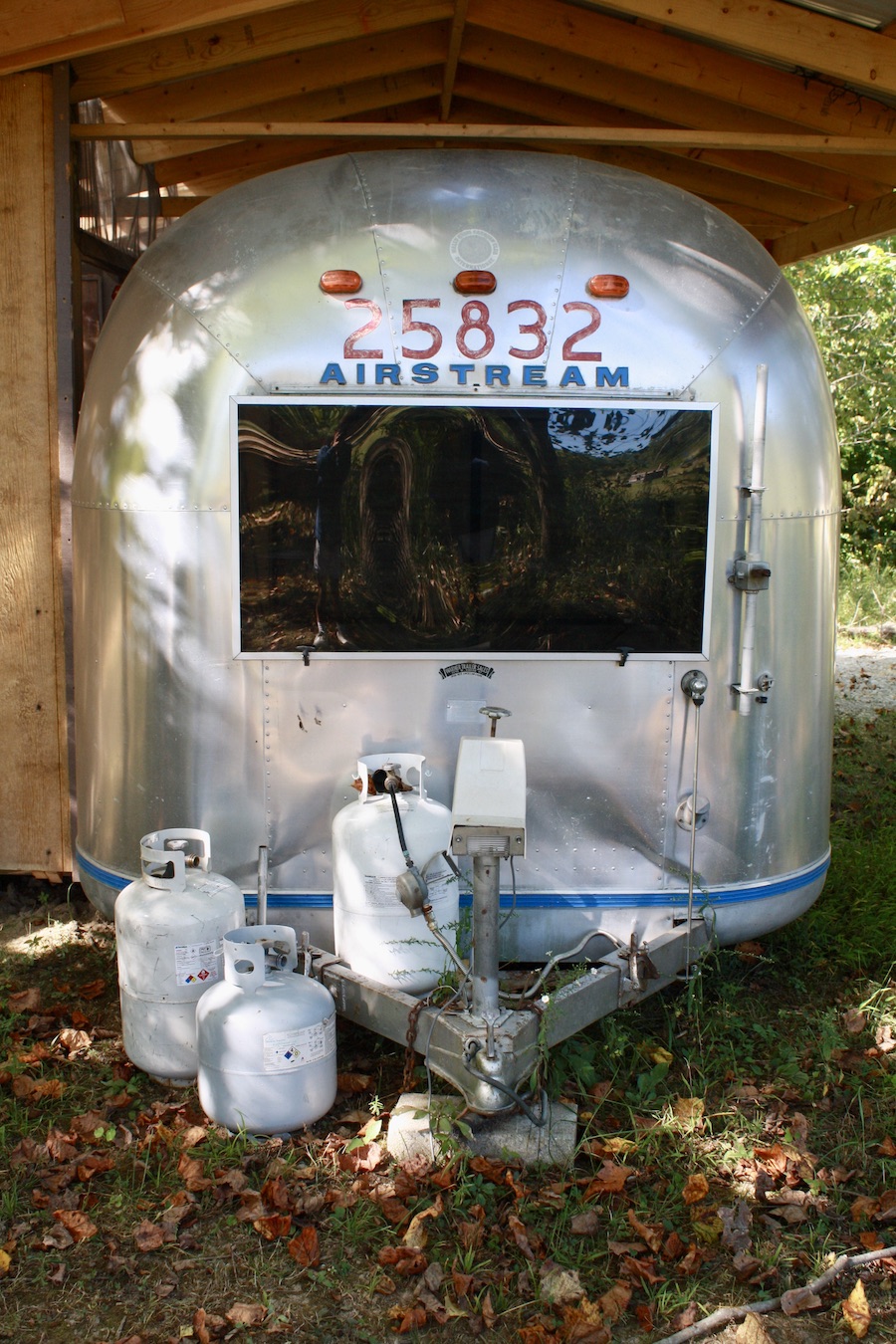
Lodging at The Hundredth Hill artist retreat includes cottages constructed of repurposed and recycled materials, a large converted barn, and a 1972 Airstream trailer (pictured) on 40 acres of property, making it ideal for artists to isolate together to nurture their creative spirits. | Photo by Grayson Pitts
Tickets for the live shows are available through the Buskirk-Chumley Box Office. So far tickets are selling as expected, but Detor knew it wouldn’t be easy to promote an event like this. “I knew from the get-go this was a sell,” says Detor. “I have to sell this show. It has to go word-of-mouth and it has to be a constant reach-out from person to person.” The Hundredth Hill isn’t a venue and, in the future, it isn’t going to be a venue. That “isn’t what we do,” Detor says. “This is an artist residence, so we want people to come here, create. We would maybe do receptions with artists, but we’re not a venue.” But the culmination of two and a half months’ collaborative effort between fervent young artists deserves a spotlight. So, this once, The Hundredth Hill is a venue.
“You’ve got to talk people into driving into the country where there are no street lights,” Detor says. “And they’ve got to come out, they’ve got to take the risk of coming to a place they’ve never been, which is a hard sell to begin with, and then they’ve got to come and take a risk to do a thing they’ve never done — which is to come out into the middle of nowhere and watch live theater in a plague. And so I knew it going in, and I kept on telling the actors, ‘We might end up with no one, because we don’t know what’s going to happen with COVID. So let’s hedge our bets with a live stream so that at least we’ve got a document, so we can say this actually happened.’”
And when it does happen, The Hundredth Hill will be prepared with a custom-built stage, room for parking, and plenty of space for social distancing. “We’ll have lots of visibility,” Detor says. “It will be amplified and lit. The [foot] traffic will go around, clearly marked around the outside in both directions.” Food will be available for pre-order on opening and closing nights, a restroom will be accessible in the barn, and congregating outside of your group’s designated space in the audience area will be discouraged for the sake of public safety.
Detor is doing the footwork to make sure these performances are successful. “I knew I was going to have to go to my friends and knock on their doors all the time, ‘Are you coming?’” she says. “I’m one-hundred-percent certain that opening and closing nights will sell out, but in the interim, I’m going to have to keep on chatting. I’ll be tap dancing my way to opening night.”
Children’s Crusade will be performed on Thursday, October 1; Friday, October 2; and Saturday, October 3, at 7:30 p.m.
Ghost Tape Number Ten will be performed on Thursday, October 8; Friday, October 9; and Saturday, October 10, at 7:45 p.m.
Tickets are available through the Buskirk-Chumley Box Office.

